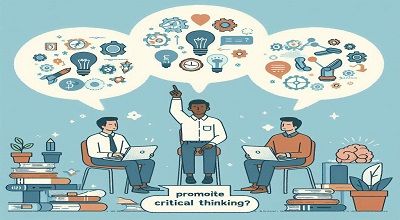Best Graphic Organizers
Graphic organizers are excellent tools for promoting critical thinking, especially for beginners who are new to the concept. They visually structure information, helping you to analyze, understand, and synthesize content more effectively.
Here are some of the best graphic organizers tailored to encourage critical thinking:
- Venn Diagrams: These are perfect for comparing and contrasting two or more items. The circles represent different items, and the overlapping areas show their similarities, while the non-overlapping areas indicate differences. It’s a simple yet powerful way to visually organize comparative information.
- Mind Maps: Mind maps start with a central idea and branch out into related topics. They’re great for brainstorming, organizing thoughts, and seeing how different pieces of information connect. This visual representation helps in understanding complex subjects and generating new ideas.
- Flowcharts: These are used to show the steps in a process or a sequence of events. They are especially helpful for understanding procedures and for problem-solving. By laying out the steps visually, you can better analyze and understand the process.
- Cause and Effect Charts: These charts help in identifying the causes of a certain event or situation and their potential effects. They’re useful for understanding the relationship between different elements and for critical analysis of events or problems.
More Read…
- Fishbone Diagrams (Ishikawa): These diagrams are used to identify potential factors causing an overall effect. Often used for problem-solving, they help in breaking down the causes of a problem into manageable, visual chunks.
- SWOT Analysis: SWOT stands for Strengths, Weaknesses, Opportunities, and Threats. This organizer helps in evaluating these four aspects of a situation, project, or business. It’s an excellent tool for strategic planning and decision-making.
- T-Charts: A T-chart is a simple organizer with two columns for comparing two aspects of a subject, like pros and cons, facts vs. opinions, or before and after scenarios. It helps in organizing thoughts in a clear, straightforward manner.
- Concept Maps: Similar to mind maps but more complex, concept maps connect multiple ideas, showing the relationships between different concepts. They’re great for understanding and organizing complex information.
- KWL Charts: Standing for “Know, Want to Know, Learned,” these charts are particularly useful in educational settings. They help in tracking learning progress and encourage inquisitive thinking.
- Story Maps: These are great for breaking down narrative structures. They can help you identify key elements like the setting, characters, plot, conflict, and resolution in a story, which is useful for both literature analysis and storytelling.
Final Words
When choosing a graphic organizer, consider your specific needs and the nature of the information or task at hand. Each type has its strengths, and the best choice will depend on what you are trying to achieve in terms of critical thinking and analysis.
